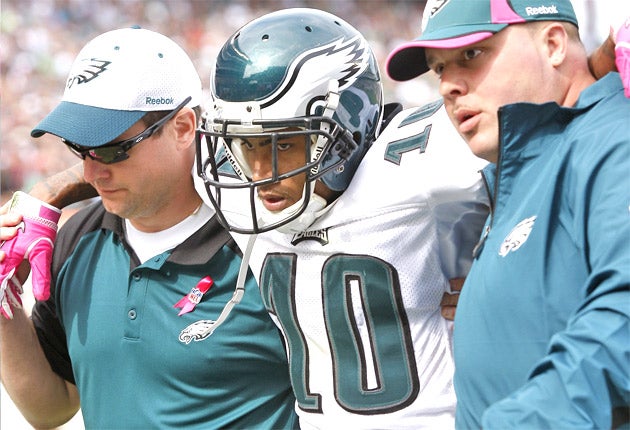NFL goes on the offensive over brutal tackles

Your support helps us to tell the story
From reproductive rights to climate change to Big Tech, The Independent is on the ground when the story is developing. Whether it's investigating the financials of Elon Musk's pro-Trump PAC or producing our latest documentary, 'The A Word', which shines a light on the American women fighting for reproductive rights, we know how important it is to parse out the facts from the messaging.
At such a critical moment in US history, we need reporters on the ground. Your donation allows us to keep sending journalists to speak to both sides of the story.
The Independent is trusted by Americans across the entire political spectrum. And unlike many other quality news outlets, we choose not to lock Americans out of our reporting and analysis with paywalls. We believe quality journalism should be available to everyone, paid for by those who can afford it.
Your support makes all the difference.The National Football League (NFL) is cracking down on illegal hits to the head, as the risk of crippling brain and spinal injuries casts a shadow over America's richest and most popular professional sport.
The latest action – which could see lengthy suspensions for players who break the League's tackling rules – comes after at least six players were left with concussions and neck injuries after on-field collisions in the latest round of games on Sunday. None of them appears to be in critical condition, but after a series of reports linking "gridiron" to long-term brain injuries – and mounting evidence of the dangers of the game even at high school and college level – the NFL has decided that it can wait no longer.
"It may be necessary to ban all hits to the head," said Ray Anderson, a top NFL official said after the weekend's mayhem. "All things will be on the table, it's not just a career-threatening situation for a guy like DeSean Jackson [a Philadelphia Eagles player who suffered a severe concussion on Sunday], but maybe life-altering as well."
The NFL long ago outlawed "spearing", when a player hurls himself helmet-first into an opponent's body. Now it appears poised to take draconian steps to prevent serious blows of any kind against the head, including multi-game suspension without pay for an offender, and potentially game-changing penalties on the field for his team.
But the changes may not be to everyone's liking – and the League will do nothing that might kill a goose that lays such golden eggs. Not only has football long supplanted baseball as America's real national pastime; the NFL is probably the richest sports league in the world, with massive television audiences and annual revenues of more than $8bn (£5bn).
Its appeal, however, largely reflects the violence inherent to the sport, and there is a fine line between what is acceptable and what is not. "I don't want to see anyone injured," said James Harrison, the Pittsburgh Steelers linebacker, after he had laid out two of his opponents on Sunday, "but I'm not opposed to hurting anyone."
Fans savour highlights reels of bone-jarring tackles by defencemen weighing 20 stone or more; for the players, macho grit and an ability to keep playing through pain are not just a point of pride, but central to their culture.
Indeed gridiron football – which has never really taken hold elsewhere in the world despite the best efforts of the NFL – has been described as the perfect metaphor for American life: militaristic, ritualised and massively commercialised, consisting of endless confabulations, punctuated by moments of extreme violence.
This is far from the first time the dangers of the sport have attracted attention: 15 years before the NFL even came into existence, President Theodore Roosevelt summoned representatives of Harvard, Yale and Princeton to the White House in 1905 to warn them that college football would be abolished if steps were not taken to make it safer.
Today, however, those dangers are greater than ever. Players are bigger, stronger and faster. Steroids have been illegal in the NFL since 1987, but are still used by some players – even in college football – to build strength and recover more quickly from injury. But that merely increases the longer-term dangers.
Recent studies have found that a disproportionate number of former NFL players suffer from CTE, or chronic traumatic encephalopathy, a disease that causes severe mental disorders and whose only known cause is repeated traumas to the head. Nor are former players the only ones at risk.
In a case that helped to focus national attention on the problem, doctors found that a 21-year-old football star at the University of Pennsylvania who committed suicide in April had been suffering from CTE. Even at high schools, among players aged from 14 to 18, an estimated 50,000 cases of concussion are recorded each year.
Before this past weekend's mayhem, the League – long criticised for failing to highlight the dangers of head injuries – had ordered posters with the word "CONCUSSION" in large letters to be displayed in every dressing room, urging players to report any colleague they suspected might have suffered a concussion, even if he claimed to be fine.
Join our commenting forum
Join thought-provoking conversations, follow other Independent readers and see their replies
Comments